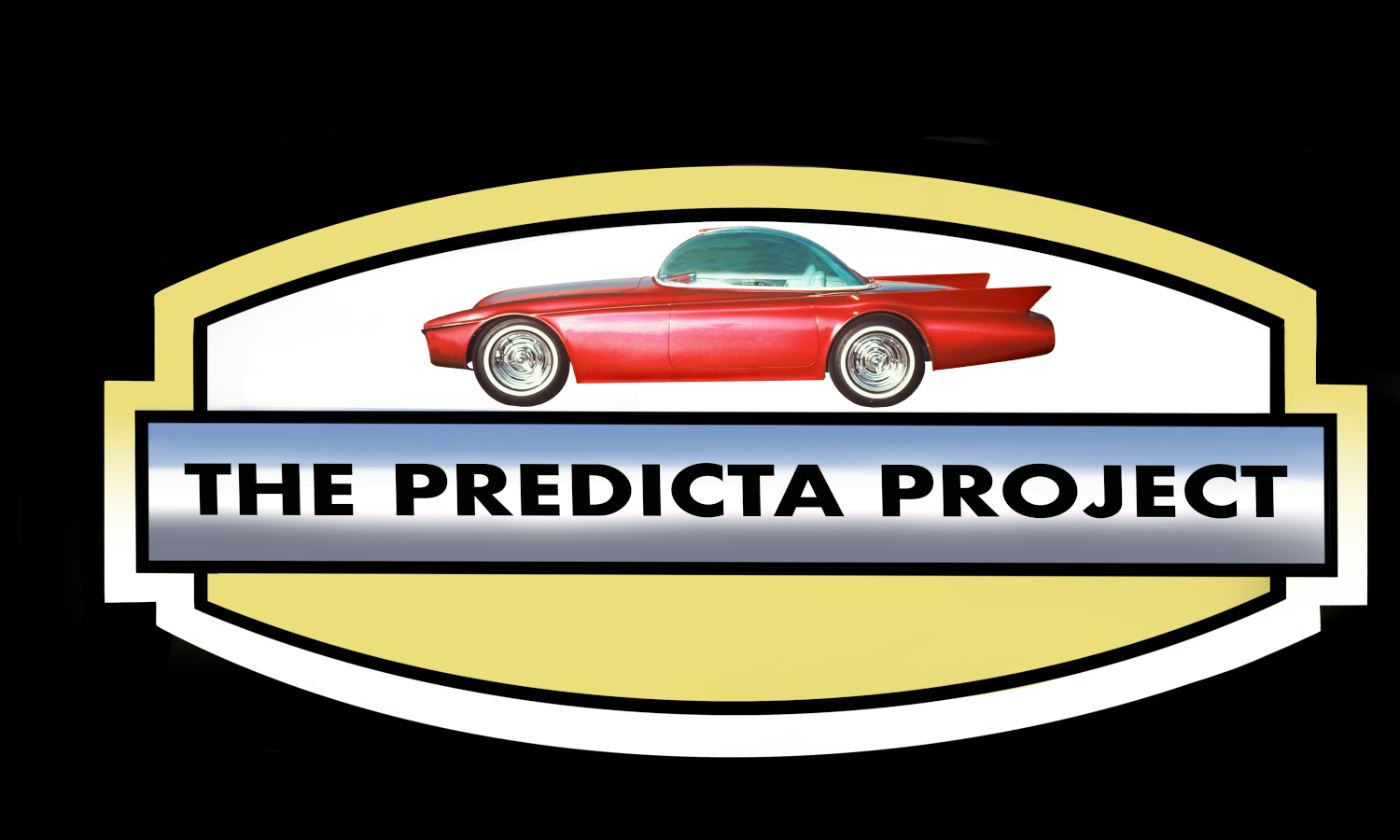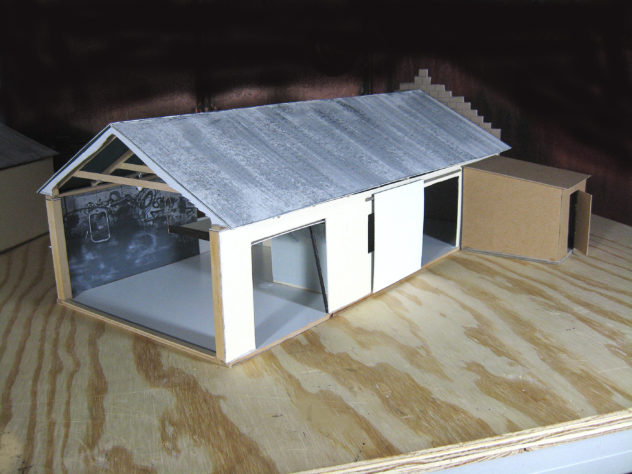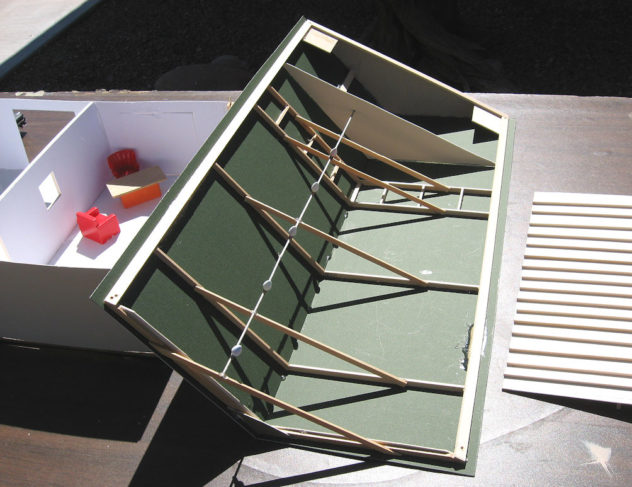But what if…
One pillar of The Predicta Project is the creation of a series of phantom kits that will speculate on possible kits that could have been produced by Monogram Models if only different marketing and related decisions had been made. Let’s face it — as valuable as it is historically to have the venerable original kit, that offering had its limitations including a misproportioned body and only minimal detailing in an era in when kit manufacturers were emphasizing authentic scale detailing.
The primary focus of this part of The Predicta Project is historical in goal and detail: We intend to reach into the past and create a series of Predicta kits that certainly could have been profitably created and marketed by Monogram in the 1962-64 era. In no particular order, these phantom kits will range from a fully-detailed “halo” kit that could would have been produced by a company anxious to compete with Johan’s legendary Turbine car model; to a 1/24-scale slot car (almost every other Monogram 1/24 static model was turned into a slot car): to a 1962 model of the first version of the car that might have participated in Monogram’s once famous and now little known Custom Car Lot promotional campaign, and to a 1/8-scale Big Predicta.
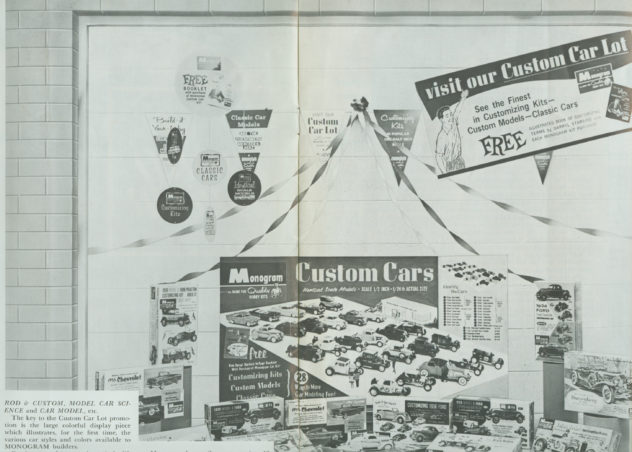
We’re also going to speculate on a kit of a very different Predicta — what would the car have been like if Starbird had been approached by Jacques Passino of the Ford Motor Company and asked to participate in that company’s very high profile Custom Car Caravan? In such an event, the car would have been restyled differently and featured more production-oriented interior seats and related features (but preserving the tiller steering). In this alternate reality Monogram — anxious to get involved with Ford — would have offered a kit of a very different Predicta and we’re going to do that kit, too. Imagine the faux-historic scene if the Predicta had been parked next to the Thunderbird Italien at the Cobo Hall show — what influence, if any, upon the Predicta would have been exerted from its high-profile participation in the Caravan? And, what Ford corporate speed equipment might have been installed as Ford sought to promote its Total Performance program? If the creation of the other kits goes well, we will consider doing this kit, too. Go here to learn about this highly speculative version that may be the most interesting scale model to emerge from this whole effort.
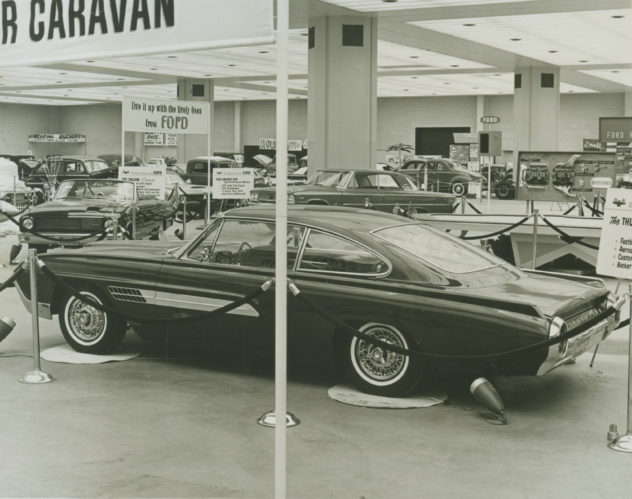
We’re also going to take the final step and create the Big Predicta — a 1/8 scale model of the car that would have taken its rightful place among the other large-scale hot rod models that Monogram very successfully marketed: The Big T, The Big Deuce, the Big Rod, the Big Drag and The Big Tub. This kit will be a stretch.
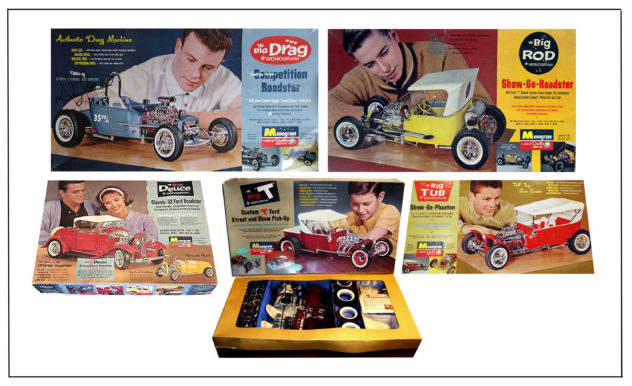
Clearly, this element of The Predicta Project will involve significant design and historic speculation — invoking the storied history of Monogram Models in the halcyon days of the early Sixties — had America’s second largest kit manufacturer carried into fact its possible intentions to create high end and diverse versions of its greatest selling kit. Freed from the actual course of events, but closely tethered to aspirational corporate plans that Roger Harney and Monogram executive Bob Reeder once told me the company had intended to pursue but for budgetary, and other concerns that quelled these plans.
Please walk through the following descriptions and let yourself float back in time to 1963-64 and imagine what might have been.
Check out the following specific descriptions of the special, phantom kits that we’ll be creating:
First Kit:
The Predicta, circa late 1961.
Theme: What if Monogram had approached Starbird earlier than it did, and had decided to offer a kit of the Predicta during the height of its second-version glory without asking Starbird to re-style the car as the company did in 1963? If such a kit might have existed, it could have been a part of the Monogram Custom Car Lot in which that company’s other model car kits played a major role, including eventually the 1955 Chevy Bel Aire and 1940 ford (these two kits included Starbird customizing parts). The 1961 version of the Predicta (which then would have been the first of the Starbird cars to be turned into a kit) would have plausibly offered customizing parts for the builder to use in building his own version of the famed show car, thereby be a legitimate part of the Custom Car Lot promotional program. To pull off this historic illusion, we’ll need to recraft the CC lot photo and create alternate versions of display adverts in use at the time.

Credit: (Photo by Robert Hegge/Pizac Photography LLC) ** ALL RIGHTS RESERVED **
The Kit: We’ll create a full-on “what if” kit that could have been issued in the 1961-62 era that would have mimicked the presentation of the then-popular Monogram car kits complete with all body parts (painted a suitable high-gloss blue to simulate Monogram plastic of the era), a complete range of mechanical and interior parts, a full instruction sheet based on the style of the 1962-era PC-prefix Monogram kit style, new decals, and fresh box art created by Brad Leisure. The kit will not feature opening doors, or other “enhanced detail” features not found in the official 1964 Monogram kit; rather, it will simply present the 1962 version of the car in this fanciful kit. Important note: this body will be based upon the “accurized” 1964 kit (see: “Second Kit” section, below) but back-engineered (in terms of the wheel well shapes, bubble top design, grille work, etc.) to depict the 1961-62 version of the car. This kit will feature resin-cast parts arranged to present a complete “faux” kit with parts on runners, “chrome” parts and all other required bits that would have permitted a 1962 modeler to have built the version of the Predicta seen on the box lid.
The faux kit will offer “customizing” options: wheels/tires, interior and grille work, as well as front and rear grille options — body customizing only offered in two other Monogram kits (the 1940 Ford Pickup and the 1955 Chevy but that were an outgrowth of Starbird’s role as the Company’s Custom Car Consultant). The HEMI engine will be presented in its second (4-carb) version. These customizing parts and styling options will be presented, in the instruction sheet, as if suggested by Starbird, and will include some of the changes that he made when he restyled the car for the “real” 1964-era car. All changes will be noted on a full-on instruction sheet.
Box Art: The box art will show the car against a background “lifted” from the setting of the 1961 Midwest car shows in which the Predicta was presented. Since it isn’t likely that a photo of the car would have been featured, I’ll commission famed illustrator Brad Leisure to create four-color artwork that will appear on the box lid and the full instruction sheet. We’re going to create a full-on “kit” of this model including instruction sheet, the kit parts (mimicking sprues), the box lid art and so forth (the kit parts will be painted to mimic the brilliant Monogram plastic from this age).
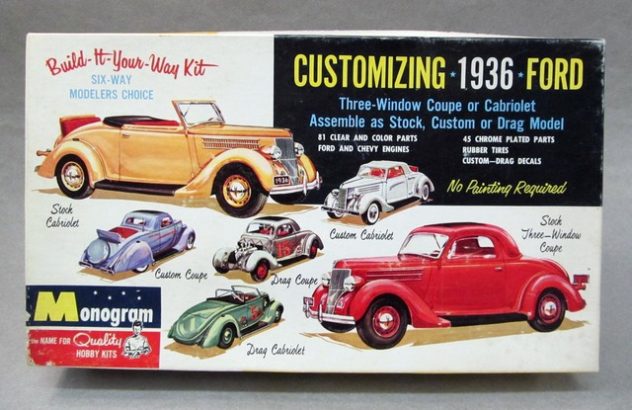
Faux History: Monogram’s Jack Besser and Bob Reder approached Starbird in late 1961 about issuing a kit of the Predicta which would have been added to the company’s Custom Car Lot program. Already the company’s designated custom car consultant, Darryl had designed custom elements for several of Monogram’s model car kits in the very early Sixties. In this alternative universe, what if Monogram had approached Starbird about issuing a kit of the Predicta in the early Fall of 1962, during the height of its second-version glory, and did NOT ask Starbird to re-style the car for the kit?
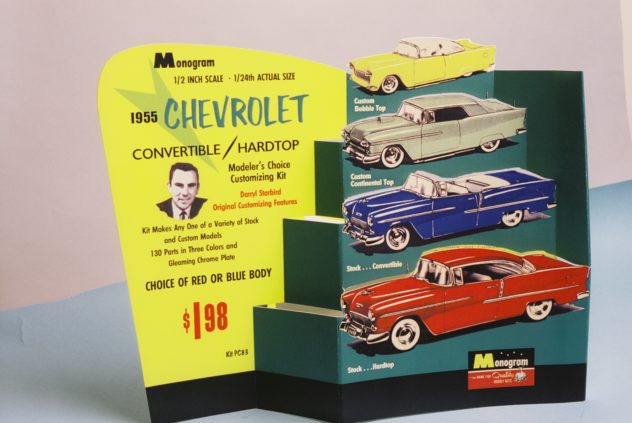
Real History:
The Custom Car Lot was Monogram’s attempt to capitalize on the hot rod and customizing trends of the early Sixties by including in their kits parts so that builders “customize” their models. The CCL promotional materials were sent to qualifying hobby stores who assembled the paraphernalia in an open space in the store or in a window open to the public.
Years ago, I purchased off Ebay an unused, complete hobby store Custom Car Lot setup. We’ll modify this impossibly rare artifact of Monogram history to include the phantom 1961 Predicta kit that will probably take the place of the Duensenberg (since it was the only factory-stock vehicle exclusively presented in the CCL photo). As necessary, we’ll modify the hobby store exhibit, and also modify the magazine adverts.
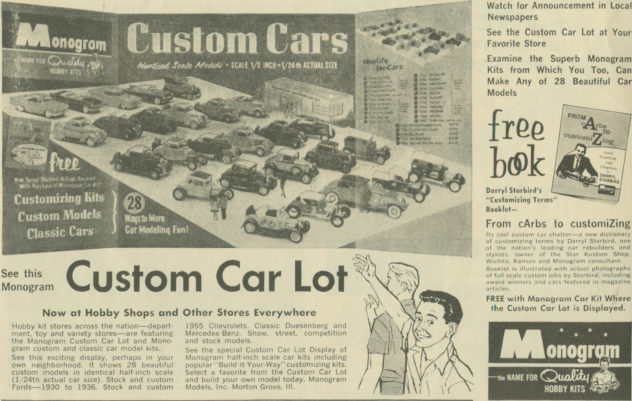
Miscellaneous: We’ll create a Predicta version of the original Monogram 1955 Chevy hobby store display. Our version of this display base will feature illustrations of the several versions of the model that could be built from parts included in the kit.
Second Kit:
“Halo” 1964 Kit
Theme: Roger Harney told me, in the late Eighties, that Monogram had briefly entertained thoughts to offer a much more realistic/detailed kit that of the Predicta that would have featured two opening doors, more comprehensive details of the Hemi engine and the Torqueflite transmission, correctly detailed suspension and steering gear, and other details. Bob Reeder vetoed the idea because of the complexities of offering opening doors that had a radius in them as well as other engineering issues. Well, nevertheless, what if such a kit had been offered — what would it have been like? We’ll answer this question by creating a fictional kit — the kit that was might have been produced.
The Kit: The Project’s superdetailed, phantom “kit that never was” will be centered around a corrected body — the Monogram body is inaccurate in several ways as we’ve learned. This Project has gathered the information on how to build a corrected body which will be reflected in the creation of an authentic kit. This revised kit — containing parts and details that might have been offered to hobbyists in 1964, but weren’t — will be based upon an accurate kit body as well as presenting a few operational parts and other details that could have been found in a more comprehensively detailed kit. Other kit manufacturers, like Johan, worked out the issues of openings on doors that weren’t flat.

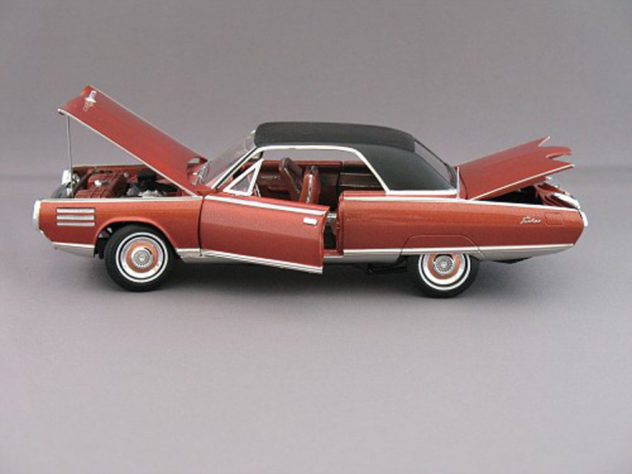
To keep within the theme of creating a phantom but entirely plausible 1964 kit, no feature or detail that couldn’t have been (technically) produced in1964 will be part of this kit; otherwise, we will not have created a persuasive artifact from the past.
With the body shape and dimensions corrected, I’m going to add a host of details that could have been offered in 1964 had there been a budget to do so. Supplementary features will include many additional parts mastered to portray the innovative Ford/Chrysler hybrid steering set up and a better-represented Hemi engine (based upon the AMT’57 Chrysler kit) and Chrysler TorqueFlite auto transmission will be included in the kit. Care will be taken to only add parts that could have been offered in 1963/64.
- Opening doors with appropriate door jamb details;
- Improved steering and suspension details including articulated upper and lower control arms, coil springs, shock and steering hookup systems (tie rods, idler arm, etc.);
- Engine compartment details to include detailed gauges mounted on the driver’s side of the front wheel shroud;
- Under hood detail structural detail (separate piece), and hinges;
- Tiller steering accurately portrayed, but front wheels will not steer;
- More detailed HEMI engine and present options for the two different engines of this era (Hillborn fuel injection);
- Other mechanical/drive train parts including rear suspension elements, gas tank and the like;’
- Enhanced front and rear grille details and lights;
- Interior detail: more detailed TV screen and controls, console gauges, gas fill tube behind the seats, etc.;
- Separate frame and underbody platform; and
- An accessory vintage lighting kit (headlights, taillights, TV screen, gauges. Monogram once offered an accessory lighting kit for model car builders and we will mimic that).
This is the original second draft decal art for the Monogram kit from late 1963. We’re turning to famed decal designer/artist Mark D. Jones to do a more sophisticated version of this art — but not so advanced that it could NOT have been made in 1964.
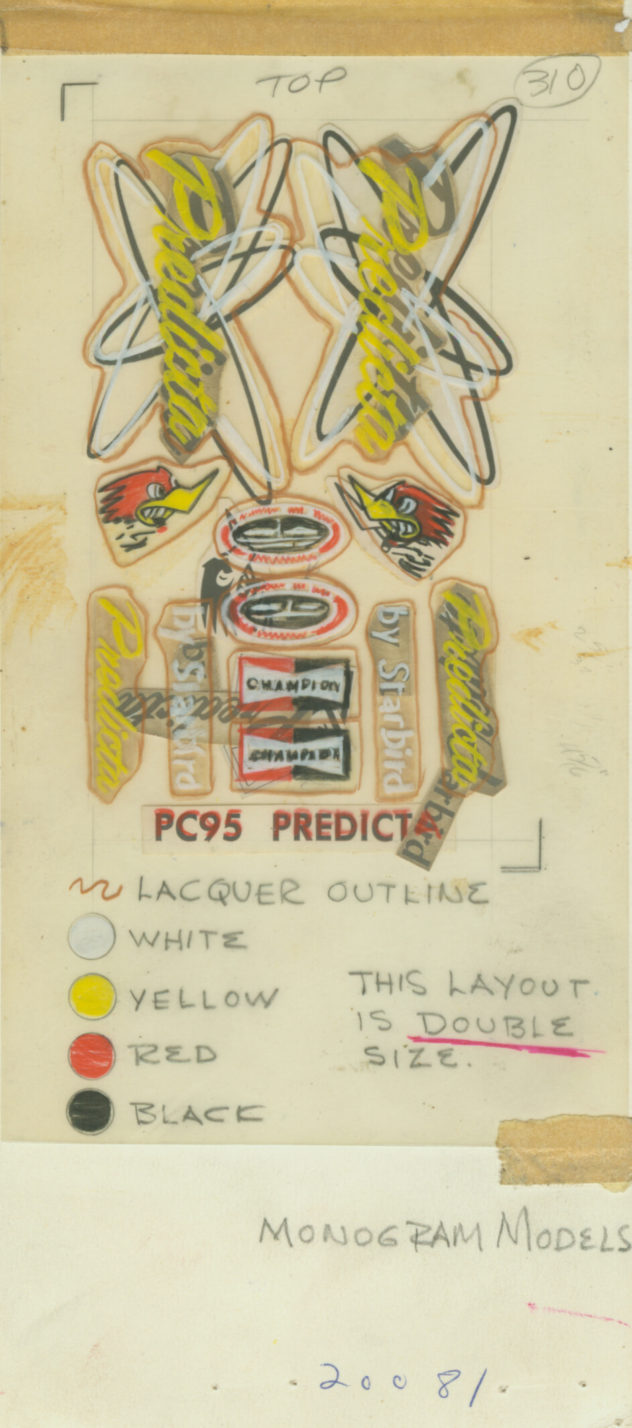
Build-Up Models: Based upon the parts in the Halo Kit, we’re going to build two versions: The first model will be a fully-detailed “contest” model with full wiring and plumbing, a full range of decals, and possibly operational lights. This version will be used for placement on the re-imagined display base and for use in alt-universe print advertisements. The second model will be a partially-built version of the car to be placed in a diorama of Darryl’s shop circa late 1962: body off the frame, fully-outfitted frame with all detail, and the like.
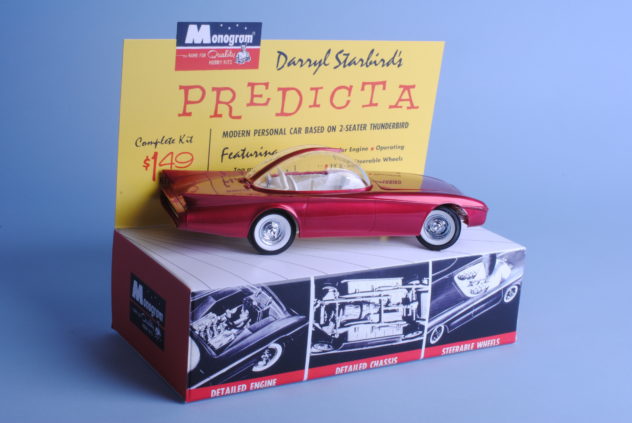
Of course, famed dioramist Jim “Hollywood” Fernandez has joined The Predicta Team — he’ll build a 1/24-scale model of Starbird’s entire first shop, complete with the walls (with graffiti), removable roof, detritus, spare parts and the like into which diorama we’ll place the primered body and the separate frame.
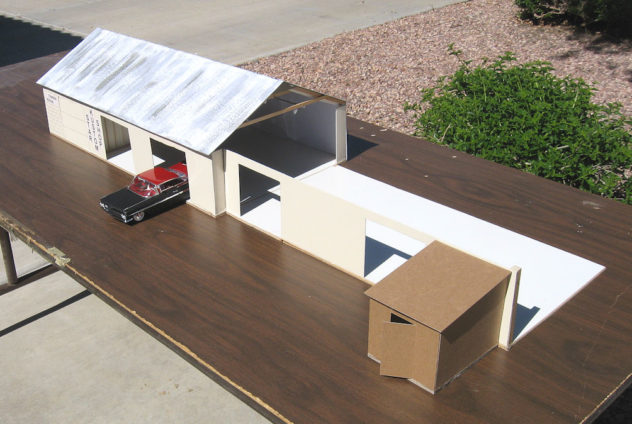
Box Art: While the box art would have clearly mimicked the kit that Monogram issued in 1963, a box for a model that featured all of enhanced mechanical and cosmetic details that would have been marketed to impress the more sophisticated builder who wanted to see what Monogram’s halo kit (so marketed) might have been like.
I’m pleased to say that I have retained the services of famous automotive illustrator Brad Leisure to create the art for this phantom kit. Relying upon some early digital help from Dave Hadley, Brad relied upon a couple of vintage 1963-era photos that I supplied (of the car immediately after it was restyled and rebuilt for Monogram) to give him clues for the box art. While not in final form, Brad has captured the essence of early Sixties Monogram advertising vibe with his design. Thanks to Brad and to Bob Wick.
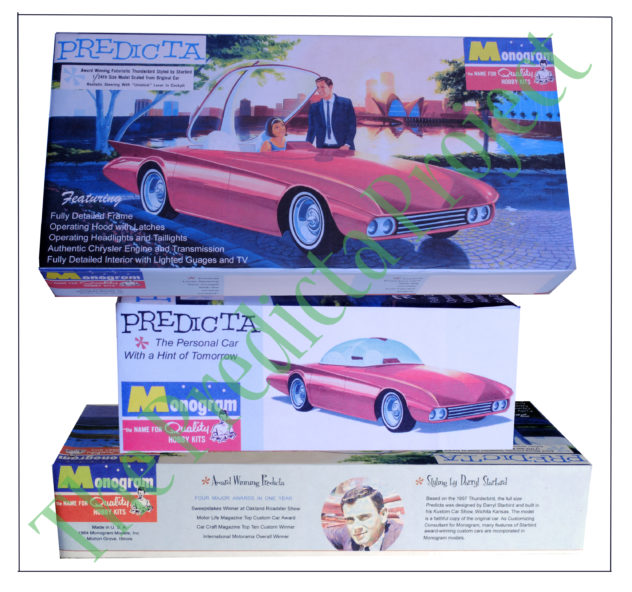
Faux History: In this alternative world, Monogram would have decided to surpass in detail and accuracy Johan’s then-just issued Turbine kit which is generally conceived as the greatest scale model car kitin 1/24-1/25 in the first Golden Age. Not to be outdone, Harney would have pulled out the stops and offered a kit to which the Turbine car kit would not have been favorably compared. Monogram’s contractual and “cultural” connection to Starbird would easily have had more “pull” with the model car hobby.
Real History: The originally intended, but frustrated, plans for a halo kit are pure speculation. That said, there were no technological obstacles to creating an over-the-top Predicta kit that would have offered operating doors, largely functional suspension operations,
Miscellaneous: As part of an effort to create a holistic, plausible “take” on what might have been one of the most interesting and detailed kits in the history of the model car hobby, we’re going to create the advertising and related ephemera that Monogram might have created to buttress and promote its halo kit. For instance, we’re going to revamp a few of the key print advertisements, the company-supplied hobby store display base, and portray the halo kit in a fresh version of the 1964 New York World’s Fair booklet that Monogram produced.
Promotional Model/Hobby Store Promotional Display: We’ll build a what-if Monogram factory display model from our faux kit (showing all of the details of this enhanced kit, but built only from our kit parts — no added “contest detail”) that Monogram would have sent out to the hobby shops to place atop the specially-created display stand that Monogram regularly provided to hobby shops in the Sixties. Of course, we’ll also recreate the accompanying Monogram-supplied hobby shop display stand that, this time, will exhibit the enhanced features of this “kit that never was” with the sides on the stand showing restaged photo subjects and angles mimicking those images that appeared on the original kit: this time each picture will depict the greater detail of this phantom kit.
We’ll use this genuine Monogram hobby story display base/model to change it to show the enhanced detail of the halo kit, and place an “out-of-the-box” model atop the box.
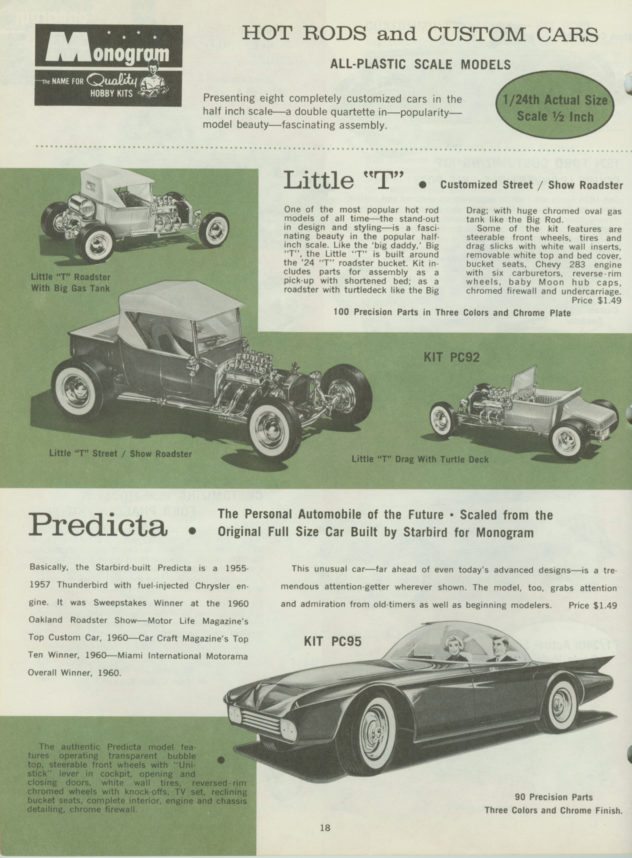
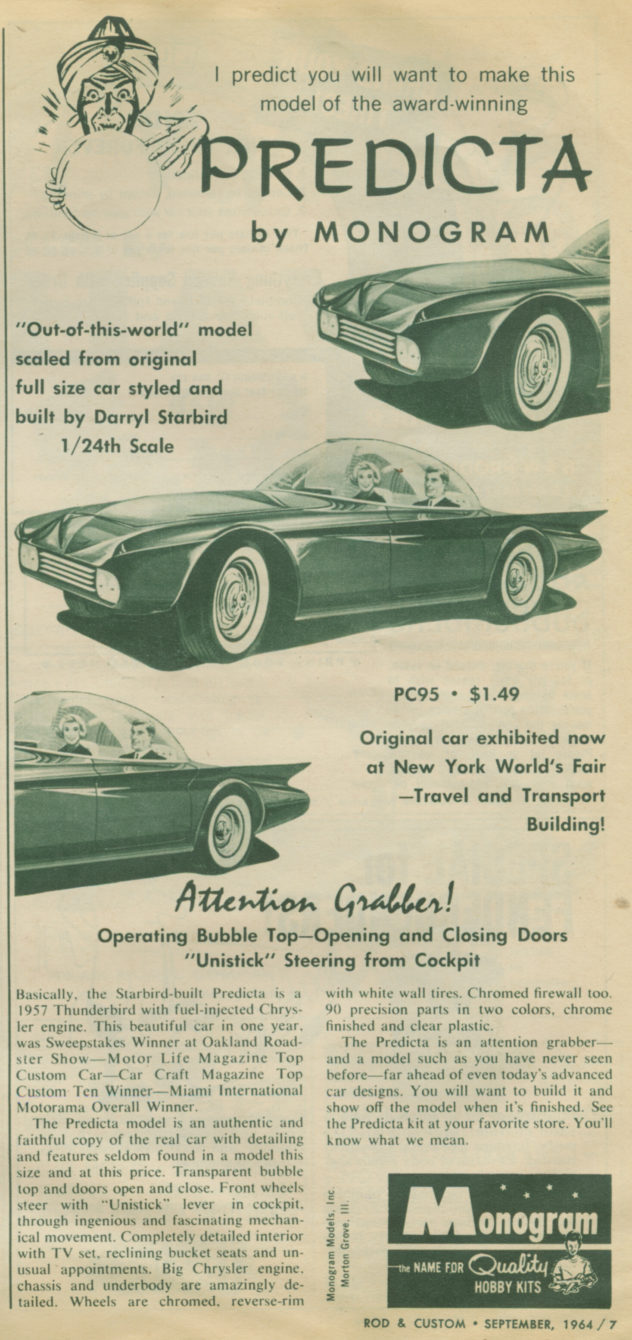
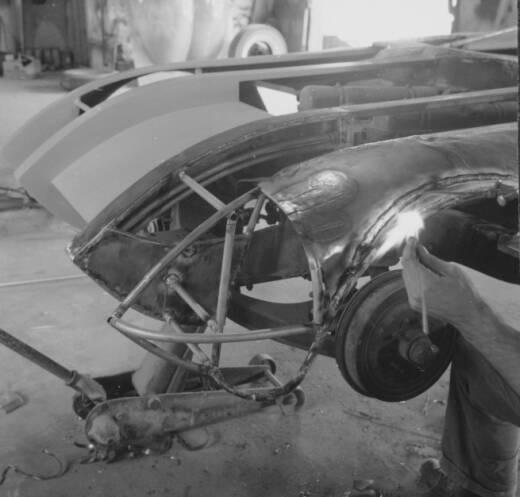
Third Kit:
The Big Predicta
Theme: The Predicta Project won’t be complete without building the Big Predicta — a 1/8 scale offering. This kit, which will be created only at very considerable effort and cost, will mimic the incredible range of 1/8 scale kits that Monogram offered in the early-to-mid Sixties. Those kits included the Big T (made into a full-scale car by Starbird), the Big Rod, Big Drag, Big Tub, Big Deuce, Big Jaguar and Big TransAm. Our Big Predicta will feature a 3-D printed body using a digital file taken from the corrected 1/24 scale Predicta body. Those 1/8 scale vintage American hot rod kits by Monogram were of extraordinary quality and accuracy. We’re going to pick up the artistic styles, fonts, box lid layout and the like for the Big Predicta.

The Kit: How We’ll Build the Body: Because we’ll need at least three of all of the parts for this full-on kit (one to photograph for the box lid, one for me to build out as the ultimate 1/8-scale model, and a complimentary kit for Darryl Starbird), it’s isn’t realistic to think that we’ll be able to scratch build three accurate, matching bodies and parts for this kit.
Therefore, we’re going to take advantage of the new 3-D printing technology to create three sets of matching parts for three complete kits. In short, we’re going to laser scan the corrected 1/24 body (discussed elsewhere on this site), enlarge those files three times to get to 1/8 scale, and then 3-D print the body. Another example: I’ve purchased an original unbuilt, now-legendary, Aurora 1/16 Hemi engine kit (widely regarded to be the best scale Hemi kit ever created thanks to Jim Keeler), scan it and then enlarge each part by twice, and then “print” the entire Hemi engine. Other parts will be scratch-built (e.g., I’m going to hire a hobby machinist to machine an accurate wheel and then we’ll scan that part and print multiple copies of the same). I’ll also accurize the old AMT 1/16 scale ‘55 Thunderbird frame and then we’ll scan and print it also after digitally enlarging it to 1/8 scale. Since no kit has ever presented accurate upper and lower control arms for a first-gen Thunderbird, I’m going to borrow or purchase a set, laser scan those parts, and then “print” those parts also.
In this way, we can create multiple, 1/8 scale, matching parts via 3-D printing so that an exhaustively complete kit can be produced — after all, Monogram could have offered much more detail than it did on its other early large scale hot rods: understand that the Big Deuce kit which offered much more detail than the Big T-based kits did.
The Big Predicta will be a complete kit with all parts on hand to build a complete Predicta with all detail — based on the assumption that Monogram wanted to create a large-scale kit with even more detail than it did on the Big Deuce kit. Emboldened by the faux-1/24 “enhanced” kit described earlier on this page, in our faux history, Monogram decided to step off the smaller scale kit and pantograph three-time larger parts (with even more additional detail both possible and required in a kit of this scale) to include the body with opening doors (full door jamb, latch detail, etc.)opening hood (with full underhood detail and latches), frame, articulated front suspension, wheels and tires, all engine parts, transmission, wheels/brakes/tires, the remarkable steering system and all interior parts. Because the Big Deuce featured operating lights, our Big Predicta kit will do the same thing. And we’ll offer customizing optional parts. All of these parts will be “sprued,” too: We’ll “fake” these sprues because these parts won’t come out of injection molds, of course.
Of course, we’ll also prepare a full instruction sheet (based, roughly, upon the style of the Big Deuce instruction sheet), decals, and a lighting kit (Monogram once offered a free-standing lighting kit for model car builders). In sum, this will be a complete kit.
Even without the hyper-detailing required of a model headed for a major competition like the GSL Championship, an out-of-the-box build up of this large scale kit would yield a very authentic model of the famed Predicta.
Box Art: This is Bob Wick’s initial layout design for the halo kit box art: Note Chicago’s Marina Towers pictured here as on the 1964 kit box lid! This image of the Predicta will appear in the revised advertisements, too, that will be created to portray kit features that “may have been.”
Of course, we’ll retain the services of Brad Leisure to produce the advert using Bob’s schematic layout of the box lid art.
Faux History: As the other 1/8-scale models were being tooled up, Roger Harney (after consulting with Starbird), decided that there were good sales were to be booked if a large scale Predicta were created. With a greater number and better rendered range of details than found in the 1/24-scale kit, this kit would have garnered much public attention.
Real History: No such kit was offered or even considered by Monogram executives.
Miscellaneous: An “out of box” model will be built for the photograph that will appear on the box lid. That’s not where the fun will be, though: A fully-detailed, contest model worthy of competition at the famed GSL International Scale Vehicle Championship will be built using the basic parts in this faux kit but augmented by a wide array of machined parts. This model will, to be the best of my efforts, be a precise 1/8-scale replica of the 1963 version of the car. This model will include ultra-realistic features, too: working door latches, operating bubble top, “working” TV set, remote control lighting for all lite features, working hood latches, a small low-voltage electric engine placed inside the HEMI engine to turn the fan (linked to a computer chip that will mimic Hemi engine sounds when the gas pedal is pushed down), and the like.
